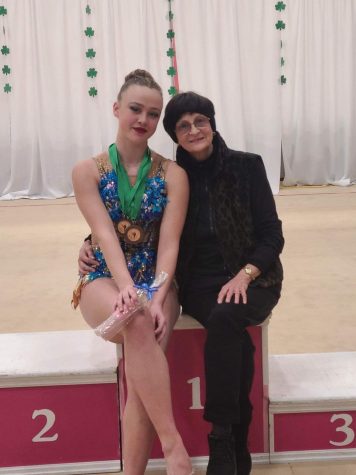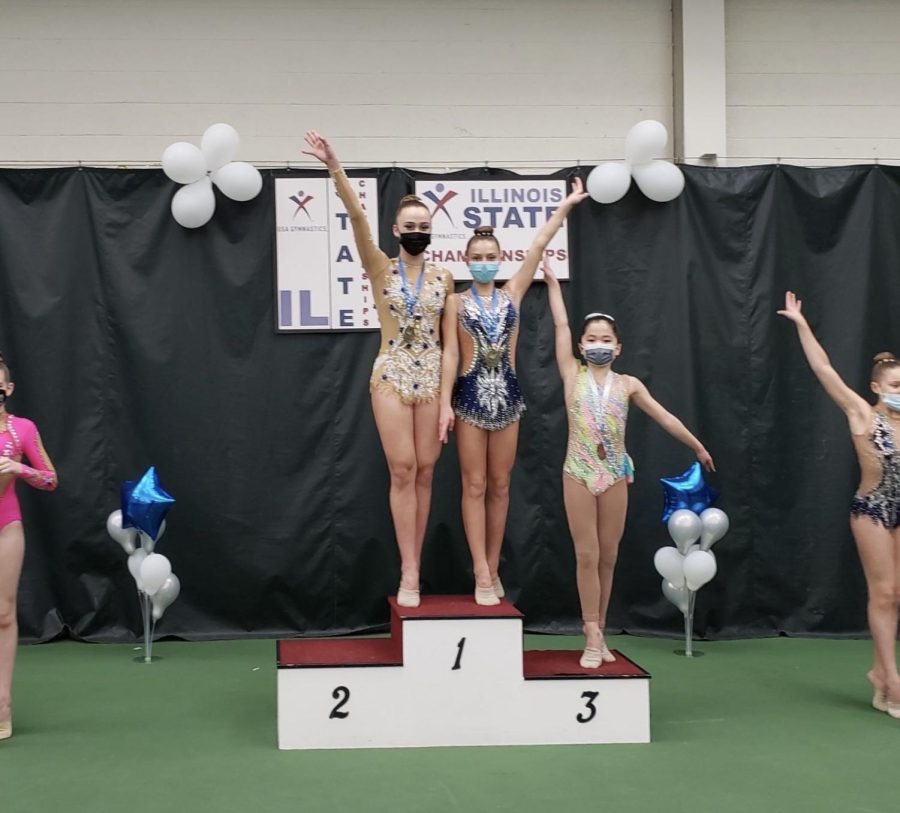Swierzb leaps to success as rhythmic gymnast
Freshman Sandra Swierzb and sophomore Laura Manelis pose for a photo after winning first place.
February 4, 2023
Head held high and hoop in hand, freshman Sandra Swierzb prances onto the performance floor in her rhinestone leotard and strikes her opening pose, ready to showcase her flexibility and dance technique throughout her two minute rhythmic routine.
In rhythmic gymnastics, gymnasts perform routines to music utilizing various equipment such as hoops, clubs, ribbons and balls while also incorporating acrobatic, flexibility and balance skills. Gymnasts receive scores for their performances based on the difficulty of their routine and the level they compete at.
Swierzb is a level nine senior rhythmic gymnast at Elite Sports Complex, where she started her training at the age of five. Swierzb discussed why she started training in rhythmic.
¨I joined rhythmic after doing normal gymnastics and my coach told me to try it. I decided to do rhythmic because it was different, and not that many people did it. I was also told by many coaches and trainers that I had much potential to be successful and reach a high level,¨ Swierzb said.
In order to train and compete at a high level, Swierzb spends many hours at the gym each week. She explained what her training plan looks like to prepare for competitions.
¨A typical practice is usually always four hours long. Twice a week for an hour we have ballet, to strengthen our muscles and work on some of our elements and the dance parts of our routines. After this we usually spend an hour on stretching and conditioning, and for about the next two hours we work on our routines. After all of this is over we usually end with 20 more minutes of conditioning,¨ Swierzb said.
Swierzb competes in hoop, ball, clubs and ribbon. She also travels throughout the Midwest and at times across the country to compete every year, typically competing in five to eight competitions per season.
Swierzb´s older sister Emilia is a current freshman at The University of Michigan and also spent many years as a rhythmic gymnast. Emilia Swierzb explained how her sister Sandra inspires her through her dedication to the sport.
¨Sandra inspires me because of her resilience. She has these huge aspirations and she is achieving them because of how hard she works. She´s got a ton on her plate practicing 16 hours a week on top of track and academics and I have so much respect for how determined she is,¨Emilia Swierzb said.

Sophomore and former rhythmic gymnast Laura Manelis met Sandra while training at Elite Sports Complex. They trained together for three years and met after being moved up to the same level.
Manelis discussed how Swierzb distinguishes herself from other athletes.
¨She has motivation to be the best and is always challenging herself with new skills every year. She also has the advantage of being naturally flexible and she works hard to improve handling the different apparatus,¨ Manelis said.
Senior Hanna Rodeck is also a former rhythmic gymnast and has known Swierzb for 10 years. After stopping rhythmic gymnastics freshman year, Rodeck returned to Elite Sports Complex in her junior year as a coach for beginner-level rhythmic classes. As both a teammate and a coach, Rodeck explained why Sandra stands out to her from other gymnasts she knows.
¨In order to be successful in rhythmic, you have to have control of your body and have the strength to maintain your skills for a long period of time. This is where Sandra stands out, she is a very physically strong person and she is in tune with her body in a way that helps her get skills easier and perform them better during competitions. Sandra is also dedicated to the sport, and she puts a lot of effort into everything she does, whether it is practices or competitions,¨ Rodeck said.
For many athletes, the transition to high school comes with many decisions. While many athletes have to choose between clubs or high school teams, rhythmic gymnasts do not have this option because rhythmic gymnastics is not offered as a high school sport in Illinois.
Sandra Swierzb decided to continue with rhythmic in high school and explained a challenge of choosing to continue her training.
¨I feel like everybody joins school sports and makes strong friendships and relationships at school, and rhythmic gymnastics just doesn’t get that opportunity,¨ Sandra Swierzb said.
With the transition to high school, continuing rhythmic gymnastics has become much more challenging for Swierzb due to the intensity of her training combined with more challenging academic classes. She explained one of the most important lessons that rhythmic gymnastics has taught her that allows her to continue her training.
¨ I’ve obviously learned many things, but one of the most important things to me is my time management. Having such a busy schedule allows me to realize the importance of certain things and motivates me to be productive,¨ Sandra Swierzb said.
Both Manelis and Rodeck chose to stop rhythmic training once they reached high school. Like many of Sandra’s former teammates, Manelis and Rodeck chose to join the dance team in high school because they come from a ballet background.
Due to the intensity and frequency of training, injuries are common for many rhythmic gymnasts. According to Fittoplay.org, the most common injuries for rhythmic gymnasts are ankle sprains, knee pain,shin splints and back pain.
Sandra’s sister Emilia had back surgery as a sophomore, which prevented her from competing in any sports for the rest of high school. Although Sandra has not suffered a career-ending injury like her sister, she is unsure of her future due to the mental and physical strain of the sport. Despite the uncertainty, Swierzb explained what she is grateful for.
¨I’m definitely happy with the friends and relationships I was able to make,¨ Sandra Swierzb said.

